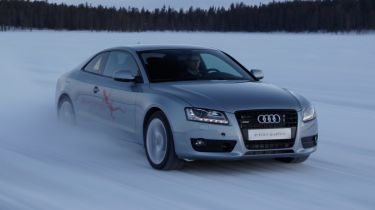Audi A5 e-tron Quattro prototype
We take an early drive in Audi’s hybrid A5 concept.

We’ve seen plenty of e-tron concepts before, but this hybrid system moves the game on a step further than Audi’s first hybrid, based on the Q5. The A5 gives the driver the choice of how and when the electric motors should be used, and its automatic mode works so seamlessly that the reality of it being adopted into the current Audi model line-up is more than just a possibility.
Meet the car of Audi’s future! Set to go on sale within the next two years, the German firm’s A5 e-tron Quattro prototype previews Audi’s latest hybrid Quattro drive train. And Auto Express is first behind the wheel.
To make the A5 e-tron, Audi has taken an A5 2.0-litre TFSI Quattro, disposed of the propshaft and added an electric motor to the rear axle.
With the propshaft removed, the transmission tunnel becomes the ideal place for the bank of lithium-ion batteries and a specially developed four-speed R-Tronic twin clutch gearbox.
A further electric motor has also been added just behind the TFSI engine which, when combined with the rear-mounted motor and petrol engine, produces 314bhp.
This ensures that the hybrid offers impressive performance – top speed is pegged at 142mph, but the 0-62mph sprint takes just 5.9 seconds, 0.6 seconds faster than the quickest 2.0-litre petrol A5 on sale now.
But perhaps more impressive are Audi’s claimed efficiency figures. Thanks to the hybrid powertrain, the A5 hybrid will return 104mpg while only emitting just 64g/km of C02 emissions.
The A5 e-tron can drive on electric power alone for around 30 miles, but this does cut the top speed to 62mph. The batteries are recharged by the petrol engine, which is managed by an on-board computer, or can be topped up from a household plug. The batteries take around two hours to fully recharge.
The even better news is that the all-wheel drive Quattro system hardly notices the missing mechanical link between engine and rear axle. Audi has developed software that manages the distribution of power to all four wheels virtually seamlessly. The system monitors the grip of all four wheels constantly, and sends toque to where it’s most needed.







